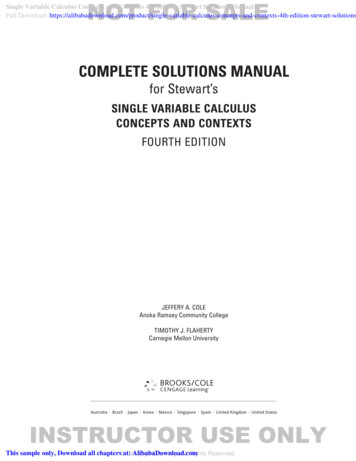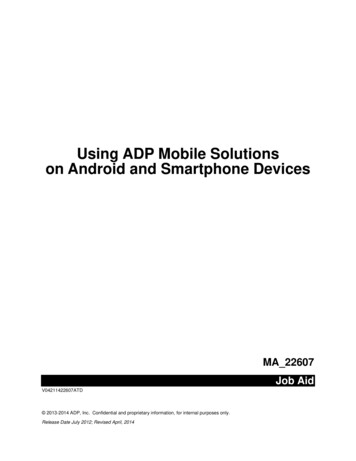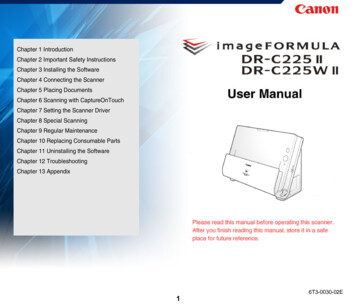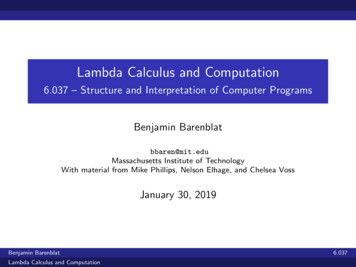
Transcription
NOT FOR SALESingle Variable Calculus Concepts and Contexts 4th Edition Stewart Solutions ManualFull Download: rt-solutionsCOMPLETE SOLUTIONS MANUALfor Stewart’sSINGLE VARIABLE CALCULUSCONCEPTS AND CONTEXTSFOURTH EDITIONJEFFERY A. COLEAnoka Ramsey Community CollegeTIMOTHY J. FLAHERTYCarnegie Mellon UniversityAustralia . Brazil . Japan . Korea . Mexico . Singapore . Spain . United Kingdom . United StatesINSTRUCTOR USE ONLYThis sample only, Download all chapters at:AlibabaDownload.comCengageLearning. All Rights Reserved.
NOT FOR SALE 2010 Brooks/Cole, Cengage LearningALL RIGHTS RESERVED. No part of this work covered by thecopyright herein may be reproduced, transmitted, stored, orused in any form or by any means graphic, electronic, ormechanical, including but not limited to photocopying,recording, scanning, digitizing, taping, Web distribution,information networks, or information storage and retrievalsystems, except as permitted under Section 107 or 108 of the1976 United States Copyright Act, without the prior writtenpermission of the publisher.For product information and technology assistance, contact us atCengage Learning Customer & Sales Support,1-800-354-9706For permission to use material from this text or product,submit all requests online at www.cengage.com/permissions.Further permissions questions can be e-mailed topermissionrequest@cengage.com.ISBN-13: 978-0-495-56060-9ISBN-10: 0-495-56060-XBrooks/Cole20 Davis DriveBelmont, CA 94002-3098USACengage Learning is a leading provider of customizedlearning solutions with office locations around the globe,including Singapore, the United Kingdom, Australia,Mexico, Brazil, and Japan. Locate your local office atwww.cengage.com/globalCengage Learning products are represented in Canada byNelson Education, Ltd.To learn more about Brooks/Cole, visitwww.cengage.com/brookscolePurchase any of our products at your local college store or atour preferred online store www.cengagebrain.com.NOTE: UNDER NO CIRCUMSTANCES MAY THIS MATERIAL OR ANY PORTION THEREOF BE SOLD, LICENSED, AUCTIONED,OR OTHERWISE REDISTRIBUTED EXCEPT AS MAY BE PERMITTED BY THE LICENSE TERMS HEREIN.READ IMPORTANT LICENSE INFORMATIONDear Professor or Other Supplement Recipient:Cengage Learning has provided you with this product (the“Supplement”) for your review and, to the extent that you adopt theassociated textbook for use in connection with your course (the“Course”), you and your students who purchase the textbook may usethe Supplement as described below. Cengage Learning has established these use limitations in response to concerns raised by authors,professors, and other users regarding the pedagogical problems stemming from unlimited distribution of Supplements.Cengage Learning hereby grants you a nontransferable license to usethe Supplement in connection with the Course, subject to the following conditions. The Supplement is for your personal, noncommercialuse only and may not be reproduced, posted electronically or distributed, except that portions of the Supplement may be provided toyour students IN PRINT FORM ONLY in connection with your instruction of the Course, so long as such students are advised that they maynot copy or distribute any portion of the Supplement to any thirdparty. You may not sell, license, auction, or otherwise redistribute theSupplement in any form. We ask that you take reasonable steps toprotect the Supplement from unauthorized use, reproduction, or distribution. Your use of the Supplement indicates your acceptance ofthe conditions set forth in this Agreement. If you do not accept theseconditions, you must return the Supplement unused within 30 days ofreceipt.All rights (including without limitation, copyrights, patents, and tradesecrets) in the Supplement are and will remain the sole and exclusiveproperty of Cengage Learning and/or its licensors. The Supplement isfurnished by Cengage Learning on an “as is” basis without any warranties, express or implied. This Agreement will be governed by andconstrued pursuant to the laws of the State of New York, withoutregard to such State’s conflict of law rules.Thank you for your assistance in helping to safeguard the integrity ofthe content contained in this Supplement. We trust you find the Supplement a useful teaching tool.INSTRUCTOR USE ONLYPrintednted in the United States of America2 3 4 5 6 7 14 13 12 1 1 Cengage Learning. All Rights Reserved.
NOT FOR SALEPREFACEThis Complete Solutions Manual contains solutions to all exercises in the texts Single VariableCalculus: Concepts and Contexts, Fourth Edition, and Chapters 1–8 of Calculus: Concepts andContexts, Fourth Edition, by James Stewart. A student version of this manual is also available; itcontains solutions to the odd-numbered exercises in each chapter section, the review sections, theTrue-False Quizzes, and the Focus on Problem Solving sections, as well as solutions to all theexercises in the Concept Checks. No solutions to the Projects appear in the student version. It isour hope that by browsing through the solutions, professors will save time in determining appropriate assignments for their particular classes.Some nonstandard notation is used in order to save space. If you see a symbol that you don’trecognize, refer to the Table of Abbreviations and Symbols on page v.We appreciate feedback concerning errors, solution correctness or style, and manual style. Anycomments may be sent directly to us at jeff.cole@anokaramsey.edu or tim@andrew.cmu.edu, orin care of the publisher: Cengage Learning Brooks/Cole, 20 Davis Drive, Belmont, CA 94002.We would like to thank Jim Stewart, for his guidance; Brian Betsill, Kathi Townes, andRebekah Million, of TECH-arts, for their production services; and Richard Stratton and JeannineLawless, of Cengage Learning Brooks/Cole, for entrusting us with this project as well as for theirpatience and support.Jeffery A. ColeAnoka Ramsey Community CollegeTimothy J. FlahertyCarnegie Mellon UniversityINSTRUCTOR USE ONLY Cengage Learning. All Rights Reserved.iii
NOT FOR SALEINSTRUCTOR USE ONLY Cengage Learning. All Rights Reserved.
NOT FOR SALEABBREVIATIONS AND SYMBOLSCDconcave downwardCUconcave upwardDthe domain of iFDTFirst Derivative TestHAhorizontal asymptote(s)Iinterval of convergenceI/DIncreasing/Decreasing TestIPin ection point(s)Rradius of convergenceVAvertical asymptote(s)CAS indicates the use of a computer algebra system.Hindicates the use of l’Hospital’s Rule.mindicates the use of Formula m in the Table of Integrals in the back endpapers.sindicates the use of the substitution {x sin { gx cos { g{}.cindicates the use of the substitution {x cos { gx sin { g{}. INSTRUCTOR USE ONLY Cengage Learning. All Rights Reserved.v
NOT FOR SALECOMPLETE SOLUTIONS MANUALfor Stewart’sMULTIVARIABLE CALCULUS:CONCEPTS AND CONTEXTSFOURTH EDITIONDAN CLEGGPalomar CollegeAustralia . Brazil . Japan . Korea . Mexico . Singapore . Spain . United Kingdom . United StatesINSTRUCTOR USE ONLY 2010 Cengage Learning. All Rights Reserved. May not be scanned, copied, or duplicated, or posted to a publicly accessible website, in whole or in part. Cengage Learning. All Rights Reserved.
NOT FOR SALE 2010 Brooks/Cole, Cengage LearningALL RIGHTS RESERVED. No part of this work covered by thecopyright herein may be reproduced, transmitted, stored, orused in any form or by any means graphic, electronic, ormechanical, including but not limited to photocopying,recording, scanning, digitizing, taping, Web distribution,information networks, or information storage and retrievalsystems, except as permitted under Section 107 or 108 of the1976 United States Copyright Act, without the prior writtenpermission of the publisher.For product information and technology assistance, contact us atCengage Learning Customer & Sales Support,1-800-354-9706For permission to use material from this text or product,submit all requests online at www.cengage.com/permissions.Further permissions questions can be e-mailed topermissionrequest@cengage.com.ISBN-13: 978-0-495-56056-2ISBN-10: 0-495-56056-1Brooks/Cole10 Davis DriveBelmont, CA 94002-3098USACengage Learning is a leading provider of customizedlearning solutions with office locations around the globe,including Singapore, the United Kingdom, Australia,Mexico, Brazil, and Japan. Locate your local office atwww.cengage.com/international.Cengage Learning products are represented in Canada byNelson Education, Ltd.To learn more about Brooks/Cole, visitwww.cengage.com/brookscole.Purchase any of our products at your local college store or atour preferred online store www.ichapters.com.NOTE: UNDER NO CIRCUMSTANCES MAY THIS MATERIAL OR ANY PORTION THEREOF BE SOLD, LICENSED, AUCTIONED,OR OTHERWISE REDISTRIBUTED EXCEPT AS MAY BE PERMITTED BY THE LICENSE TERMS HEREIN.READ IMPORTANT LICENSE INFORMATIONDear Professor or Other Supplement Recipient:Cengage Learning has provided you with this product (the“Supplement”) for your review and, to the extent that you adopt theassociated textbook for use in connection with your course (the“Course”), you and your students who purchase the textbook may usethe Supplement as described below. Cengage Learning has established these use limitations in response to concerns raised by authors,professors, and other users regarding the pedagogical problems stemming from unlimited distribution of Supplements.Cengage Learning hereby grants you a nontransferable license to usethe Supplement in connection with the Course, subject to the following conditions. The Supplement is for your personal, noncommercialuse only and may not be reproduced, posted electronically or distributed, except that portions of the Supplement may be provided toyour students IN PRINT FORM ONLY in connection with your instruction of the Course, so long as such students are advised that they maynot copy or distribute any portion of the Supplement to any thirdparty. You may not sell, license, auction, or otherwise redistribute theSupplement in any form. We ask that you take reasonable steps toprotect the Supplement from unauthorized use, reproduction, or distribution. Your use of the Supplement indicates your acceptance ofthe conditions set forth in this Agreement. If you do not accept theseconditions, you must return the Supplement unused within 30 days ofreceipt.All rights (including without limitation, copyrights, patents, and tradesecrets) in the Supplement are and will remain the sole and exclusiveproperty of Cengage Learning and/or its licensors. The Supplement isfurnished by Cengage Learning on an “as is” basis without any warranties, express or implied. This Agreement will be governed by andconstrued pursuant to the laws of the State of New York, withoutregard to such State’s conflict of law rules.Thank you for your assistance in helping to safeguard the integrity ofthe content contained in this Supplement. We trust you find the Supplement a useful teaching tool.INSTRUCTOR USE ONLYPrintednted in Canada1 2 3 4 5 6 7 13 12 11 10 0 9 2010 Cengage Learning. All Rights Reserved. May not be scanned, copied, or duplicated, or posted to a publicly accessible website, in whole or in part. Cengage Learning. All Rights Reserved.
NOT FOR SALEPREFACEThis Complete Solutions Manual contains detailed solutions to all exercises in the textMultivariable Calculus: Concepts and Contexts, Fourth Edition (Chapters 8–13 of Calculus:Concepts and Contexts, Fourth Edition) by James Stewart. A Student Solutions Manual is alsoavailable, which contains solutions to the odd-numbered exercises in each chapter section, reviewsection, True-False Quiz, and Focus on Problem Solving section as well as all solutions to theConcept Check questions. (It does not, however, include solutions to any of the projects.)While I have extended every effort to ensure the accuracy of the solutions presented, I wouldappreciate correspondence regarding any errors that may exist. Other suggestions or commentsare also welcome, and can be sent to me at the email address or mailing address below.I would like to thank James Stewart for entrusting me with the writing of this manual and offering suggestions, Kathi Townes, Stephanie Kuhns, and Rebekah Steele of TECH-arts for typesetting and producing this manual, and Brian Betsill of TECH-arts for creating the illustrations.Brian Karasek prepared solutions for comparison of accuracy and style in addition to proofreading manuscript; his assistance and suggestions were very helpful and much appreciated. Finally,I would like to thank Richard Stratton and Elizabeth Neustaetter of Brooks/Cole, CengageLearning for their trust, assistance, and patience.DA N C L E G Gdclegg@palomar.eduPalomar CollegeDepartment of Mathematics1140 West Mission RoadSan Marcos, CA 92069INSTRUCTOR USE ONLY 2010 Cengage Learning. All Rights Reserved. May not be scanned, copied, or duplicated, or posted to a publicly accessible website, in whole or in part. Cengage Learning. All Rights Reserved.iii
NOT FOR SALEINSTRUCTOR USE ONLY Cengage Learning. All Rights Reserved.
NOT FOR SALECONTENTS 88.1Sequences1Laboratory Project Logistic SequencesSeries8.3The Integral and Comparison Tests; Estimating Sums8.4Other Convergence Tests8.5Power Series8.6Representations of Functions as Power Series8.7Taylor and Maclaurin Series8.81332 4655An Elusive LimitApplications of Taylor PolynomialsReview6970Radiation from the Stars 8183Focus on Problem Solving95VECTORS AND THE GEOMETRY OF SPACE9.1Three-Dimensional Coordinate Systems9.2Vectors9.3The Dot Product9.4The Cross Product101115122The Geometry of a Tetrahedron Equations of Lines and PlanesLaboratory Project Putting 3D in PerspectiveFunctions and Surfaces9.7Cylindrical and Spherical CoordinatesLaboratory Project1301329.6Review101108Discovery Project9.52639Applied Project 98.2Laboratory Project91INFINITE SEQUENCES AND SERIES141143 151Families of Surfaces156158Focus on Problem Solving169INSTRUCTOR USE ONLY 2010 Cengage Learning. All Rights Reserved. May not be scanned, copied, or duplicated, or posted to a publicly accessible website, in whole or in part. Cengage Learning. All Rights Reserved.v
vi NOT FOR SALECONTENTS10 VECTOR FUNCTIONS17510.1Vector Functions and Space Curves10.2Derivatives and Integrals of Vector Functions10.3Arc Length and Curvature10.4Motion in Space: Velocity and AccelerationApplied Project10.5218225231PARTIAL DERIVATIVES23911.1Functions of Several Variables11.2Limits and Continuity11.3Partial Derivatives11.4Tangent Planes and Linear Approximations11.5The Chain Rule11.6Directional Derivatives and the Gradient Vector11.7Maximum and Minimum Values249272280 Lagrange Multipliers290302Designing a DumpsterDiscovery Project11.8239256Applied Project318Quadratic Approximations and Critical Points320323Applied Project Rocket ScienceApplied Project Hydro-Turbine OptimizationReview333335338Focus on Problem Solving12 208219Focus on Problem Solving11 185195Kepler’s Laws Parametric SurfacesReview175MULTIPLE INTEGRALS35135712.1Double Integrals over Rectangles12.2Iterated Integrals12.3Double Integrals over General Regions12.4Double Integrals in Polar Coordinates12.5Applications of Double Integrals12.6Surface Area357362368380386395INSTRUCTOR USE ONLY 2010 Cengage Learning. All Rights Reserved. May not be scanned, copied, or duplicated, or posted to a publicly accessible website, in whole or in part. Cengage Learning. All Rights Reserved.
NOT FOR SALE12.7Triple IntegralsVolumes of Hyperspheres Roller Derby Discovery ProjectThe Intersection of Three Cylinders 429VECTOR CALCULUS44745313.1Vector Fields45313.2Line Integrals45813.3The Fundamental Theorem for Line Integrals13.4Green’s Theorem13.5Curl and Divergence13.6Surface Integrals48613.7Stokes’ Theorem49713.8The Divergence TheoremAPPENDIXES478501505515519DPrecise Definitions of LimitsHPolar CoordinatesComplex Numbers519519Discovery ProjectI466471Focus on Problem Solving 427435Focus on Problem SolvingReview417425Change of Variables in Multiple IntegralsReview13 416Triple Integrals in Cylindrical and Spherical CoordinatesApplied Project12.9 400Discovery Project12.8CONTENTS Conic Sections in Polar Coordinates543544INSTRUCTOR USE ONLY 2010 Cengage Learning. All Rights Reserved. May not be scanned, copied, or duplicated, or posted to a publicly accessible website, in whole or in part. Cengage Learning. All Rights Reserved.vii
NOT FOR SALEINSTRUCTOR USE ONLY Cengage Learning. All Rights Reserved.
NOT FOR SALE8INFINITE SEQUENCES AND SERIES8.1 Sequences1. (a) A sequence is an ordered list of numbers. It can also be defined as a function whose domain is the set of positive integers.(b) The terms dq approach 8 as q becomes large. In fact, we can make dq as close to 8 as we like by taking q sufficientlylarge.(c) The terms dq become large as q becomes large. In fact, we can make dq as large as we like by taking q sufficiently large.2. (a) From Definition 1, a convergent sequence is a sequence for which lim dq exists. Examples: {1@q}, {1@2q }q (b) A divergent sequence is a sequence for which lim dq does not exist. Examples: {q}, {sin q}q 3. The first six terms of dq 1 2 3 4 5 61qare , , , ,,. It appears that the sequence is approaching .2q 13 5 7 9 11 132q11 lim q 2q 1q 2 1@q2lim4. {cos(q @3)}9q 1 1 12 1 12 12 1 12 12 12. The sequence does not appear to have a limit. The values will cyclethrough the first six numbers in the sequence—never approaching a particular number.5.1 13 15 17 19 . The denominator of the nth term is the nth positive odd integer, so dq 1.2q 16.1 13 19 3q 11127 81 7. {2 7 12 17 }.8.1.Each term is larger than the preceding one by 5, so dq d1 g(q 1) 2 5(q 1) 5q 3.34 14 29 16 25 . The numerator of the qth term is q and its denominator is (q 1)2 . Including the alternating signs,we get dq ( 1)q9. The denominator of the nth term is the (q 1)st power of 3, so dq q.(q 1)2 q 181 23 49 27 . Each term is 23 times the preceding one, so dq 23.10. {5 1 5 1 5 1 }.The average of 5 and 1 is 3, so we can think of the sequence as alternately adding 2 and 2 to 3.Thus, dq 3 ( 1)q 1 · 2.11. dq 3 5q2(3 5q2 )@q25 3@q25 0, so dq 5 as q . Converges q q2(q q2 )@q21 1@q1 012. dq q3@q3q311 1 as q . Converges , so dq q3 1(q3 1)@q31 1@q31 013. dq 1 (0 2)q , so lim dq 1 0 1 by (7).q ConvergesINSTRUCTOR USE ONLY 2010 Cengage Learning. All Rights Reserved. May not be scanned, copied, or duplicated, or posted to a publicly accessible website, in whole or in part. Cengage Learning. All Rights Reserved.1
2 CHAPTER 814. dq NOT FOR SALEINFINITE SEQUENCESEQUENCES ANDAN SERIESq3@qq2q3 , so dq as q since lim q2 and lim (1 1@q2 ) 1. Divergesq q q 1(q 1)@q1 1@q215. Because the natural exponential function is continuous at 0, Theorem 5 enables us to writelim dq lim h1@q hlimq (1@q) h0 1 Convergesq 16. dq q q q3q 232 3q q 9 35 , so lim dq 9 lim 35 9 · 0 0 by (7) with u 35 . Convergesqq q 55(2q )@q2q22, then lim eq lim lim . Since tan is continuous atq q (1 8q)@qq 1@q 81 8q84 2q2qTheorem 5, lim tan tan lim tan 1. Convergesq q 1 8q1 8q417. If eq ,4by18. Using the last limit law for sequences and the continuity of the square root function,ulim dq limq 19. dq q q 1 9q 1uq 1 limq 9q 1v1 1@q limq 9 1@qu11 . Converges93( 1)q 1 q1( 1)q 11 , so 0 dq 0 as q , so dq 0 by the Squeeze Theorem and2q 1q 1@qq 1@qqTheorem 4. Converges20. dq 1( 1)q q3q3. Now dq 3 2 2q 1q 2q2 11 q2 q31q3 1 as q , but the terms of the sequence {dq }alternate in sign, so the sequence d1 d3 d5 converges to 1 and the sequence d2 d4 d6 converges to 1.This shows that the given sequence diverges since its terms don’t approach a single real number.21. dq hq h q h q1 h 2q 0 as q because 1 h 2q 1 and hq h q . Converges·h2q 1 h qhq h q22. dq cos(2@q).23. dq q2 h q As q , 2@q 0, so cos(2@q) cos 0 1 because cos is continuous. Converges{2 H2{ H2q2. Since lim { lim { lim { 0, it follows from Theorem 2 that lim dq 0. Convergesq{ h{ h{ hq h24. 2q as q , so since lim arctan { { 25. 0 cos2 q1 q2q2,2we have lim arctan 2q q 1 0,q 2q[since 0 cos2 q 1], so since lim26. dq q cos q q( 1)q .cos2 q2q.2Convergesconverges to 0 by the Squeeze Theorem.Since dq q as q , the given sequence diverges. { 227. 1 { 2, so ln { ln 1 { 12 21 2@{{ln(1 2@{) H2lim ln lim 2 lim lim{ { { { 1 2@{1@{ 1@{2 { q22lim 1 lim hln h2 , so by Theorem 2, lim 1 h2 . Convergent{ { q {qINSTRUCTOR USE ONLY 2010 Cengage Learning. All Rights Reserved. May not be scanned, copied, or duplicated, or posted to a publicly accessible website, in whole or in part. Cengage Learning. All Rights Reserved.
NOT FOR SALESECTION 8.1SEC28. dq SEQUENCES q 1 3q2 (21 3q )1@q (21 23q )1@q 21@q 23 8 · 21@q , solim dq 8 lim 21@q 8 · 2limq (1@q) 8 · 20 8 by Theorem 5, since the function i ({) 2{ is continuous at 0.q q Convergent29. dq (2q 1)!1(2q 1)! 0 as q . Converges(2q 1)!(2q 1)(2q)(2q 1)!(2q 1)(2q)30. dq 1sin 2q11 1 . dq and lim 0, so dq q 1 1 q1 qq1 q1 q lim dq 0 by theq Squeeze Theorem. Converges31. {0 1 0 0 1 0 0 0 1 } diverges since the sequence takes on only two values, 0 and 1, and never stays arbitrarily close toeither one (or any other value) for q sufficiently large.32. lim{ (ln {)2 H2(ln {)(1@{)ln { H1@{(ln q)2 2 lim 0, so by Theorem 3, lim 0. Convergent lim 2 lim{ { {{ 1q {1q33. dq ln(2q2 1) ln(q2 1) ln34. 0 ? dq 2q2 1q2 1 ln2 1@q21 1@q23 3 3333 3 33q · · · ··· ·· · ·q!1 2 3(q 1) q1 2 q ln 2 as q . Convergent[for q A 2] 27 0 as q , so by the Squeeze2qTheorem and Theorem 4, {( 3)q@q!} converges to 0.35.From the graph, it appears that the sequence converges to 1.{( 2@h)q } converges to 0 by (7), and hence {1 ( 2@h)q }converges to 1 0 1.36.From the graph, it appears that the sequence converges to a numbergreater than 3. sin@ q lim dq lim q sin lim·q q q q@ qk lsin {·{ @ q 1 · lim{{ 0 INSTRUCTOR USE ONLY 2010 Cengage Learning. All Rights Reserved. May not be scanned, copied, or duplicated, or posted to a publicly accessible website, in whole or in part. Cengage Learning. All Rights Reserved.3
4 CHAPTER 8NOT FOR SALEINFINITE SEQUENCESEQUENCES ANDAN SERIESFrom the graph, it appears that the sequence converges to 12 .37.As q ,vu3 2q23@q2 2 dq 28q q8 1@qu 0 2 8 0u11 ,42so lim dq 12 .q From the graph, it appears that the sequence converges to 5 q qqq5 5 q 3q 5q q 5q 5q 2 5qkl q 2 · 5 5 as q lim 21@q 20 138.q Hence, dq 5 by the Squeeze Theorem.Alternate solution: Let (3{ 5{ )1@{ . Thenln (3{ 5{ ) H3{ ln 3 5{ ln 5 lim limlim ln lim{ { { { {3{ 5{so lim hln 5 5, and so{ q q3 5q 3 {ln 3 ln 55 3 { ln 5, 15converges to 5.From the graph, it appears that the sequence {dq } 39.q2 cos q1 q2isdivergent, since it oscillates between 1 and 1 (approximately). Toprove this, suppose that {dq } converges to O. If eq {eq } converges to 1, and limq limq q2, then1 q2dqdqO O. But cos q, soeq1eqdqdoes not exist. This contradiction shows that {dq } diverges.eqFrom the graph, it appears that the sequence approaches 0.40.0 ? dq 352q 11 · 3 · 5 · · · · · (2q 1)1··· ··· · (2q)q2q 2q 2q2q11· (1) · (1) · · · · · (1) 0 as q 2q2q1 · 3 · 5 · · · · · (2q 1)converges to 0.So by the Squeeze Theorem,(2q)q 41. (a) dq 1000(1 06)q d1 1060, d2 1123 60, d3 1191 02, d4 1262 48, and d5 1338 23.(b) lim dq 1000 lim (1 06)q , so the sequence diverges by (7) with u 1 06 A 1.INSTRUCTOR USE ONLYq q q q 2010 Cengage Learning. All Rights Reserved. May not be scanned, copied, or duplicated, or posted to a publicly accessible website, in whole or in part. Cengage Learning. All Rights Reserved.
NOT FOR SALESECTION 8.1SEC 42. (a) Substitute 1 to 6 for q in Lq 100SEQUENCES 5 1 0025q 1 q to get L1 0, L2 0 25, L3 0 75, L4 1 50,0 0025L5 2 51, and L6 3 76.(b) For two years, use 2 · 12 24 for q to get 70 28.43. (a) We are given that the initial population is 5000, so S0 5000. The number of catfish increases by 8% per month and isdecreased by 300 per month, so S1 S0 8%S0 300 1 08S0 300, S2 1 08S1 300, and so on. Thus,Sq 1 08Sq 1 300.(b) Using the recursive formula with S0 5000, we get S1 5100, S2 5208, S3 5325 (rounding any portion of acatfish), S4 5451, S5 5587, and S6 5734, which is the number of catfish in the pond after six months. 12 dq44. dq 1 if dq is an even number3dq 1 if dq is an odd numberWhen d1 11, the first 40 terms are 11, 34, 17, 52, 26, 13, 40, 20, 10, 5,16, 8, 4, 2, 1, 4, 2, 1, 4, 2, 1, 4, 2, 1, 4, 2, 1, 4, 2, 1, 4, 2, 1, 4, 2, 1, 4, 2, 1, 4. When d1 25, the first 40 terms are 25, 76, 38,19, 58, 29, 88, 44, 22, 11, 34, 17, 52, 26, 13, 40, 20, 10, 5, 16, 8, 4, 2, 1, 4, 2, 1, 4, 2, 1, 4, 2, 1, 4, 2, 1, 4, 2, 1, 4.The famous Collatz conjecture is that this sequence always reaches 1, regardless of the starting point d1 .45. (a) d1 1, dq 1 4 dq for q 1.d1 1, d2 4 d1 4 1 3, d3 4 d2 4 3 1,d4 4 d3 4 1 3, d5 4 d4 4 3 1. Since the terms of the sequence alternate between 1 and 3,the sequence is divergent.(b) d1 2, d2 4 d1 4 2 2, d3 4 d2 4 2 2. Since all of the terms are 2, lim dq 2 and hence, theq sequence is convergent.46. (a) Since lim dq O, the terms dq approach O as q becomes large. Because we can make dq as close to O as we wish,q dq 1 will also be close, and so lim dq 1 O.q (b) d1 1, d2 11111 0 5, d3 1 d11 121 d21 d4 11 1 d31 23d6 11 1 d51 58d8 1121 1 d7341 1321d10 311 0 6, d5 51 d41 8131155 34 1 d9891 5535 12 235 0 625,81113 8 1 d6211 130 61538, d7 0 61765, d9 1134 1 d8551 21340 61800. It appears that lim dqq 0 66667,0 61905,0 61818,0 618; hence, the sequence is convergent.(c) If O lim dq then lim dq 1 O also, so O must satisfyq O 1@(1 O)q O2 O 1 0 O 1 2 50 618 (since O has to be non-negative if it exists).INSTRUCTOR USE ONLY 2010 Cengage Learning. All Rights Reserved. May not be scanned, copied, or duplicated, or posted to a publicly accessible website, in whole or in part. Cengage Learning. All Rights Reserved.
6 CHAPTER 8NOT FOR SALEINFINITE SEQUENCESEQUENCES ANDAN SERIES47. (a) Let dq be the number of rabbit pairs in the nth month. Clearly d1 1 d2 . In the nth month, each pair that is2 or more months old (that is, dq 2 pairs) will produce a new pair to add to the dq 1 pairs already present. Thus,dq dq 1 dq 2 , so that {dq } {iq }, the Fibonacci sequence.iq 1iq(b) dq dq 1 iqiq 1 iq 2iq 211 1 1 1 . If O lim dq ,q iq 1iq 1iq 1iq 1 /iq 2dq 2then O lim dq 1 and O lim dq 2 , so O must satisfy O 1 q q 1O O2 O 1 0 O 1 52[since O must be positive].48. Fort s s qqq2, 2 2, 2 2 2, , d1 21@2 , d2 23@4 , d3 27@8 , , so dq 2(2 1)@2 21 (1@2 ) .q)lim dq lim 21 (1@2q q 21 2.Alternate solution: Let O lim dq . (We could show the limit exists by showing that {dq } is bounded and increasing.)q Then O must satisfy O 49. dq 1111is decreasing since dq 1 ? dq for each q 1. The sequence is2q 32(q 1) 32q 52q 3bounded since 0 ? dq 50. dq 2 · O O2 2O O(O 2) 0. O 6 0 since the sequence increases, so O 2.15for all q 1. Note that d1 15 .2{ 32q 3defines an increasing sequence since for i ({) ,3q 43{ 4i 0 ({) (3{ 4)(2) (2{ 3)(3)17 A 0. The sequence is bounded since dq d1 17 for q 1,2(3{ 4)(3{ 4)2and dq ?2q22q 3? for q 1.3q3q351. The terms of dq q( 1)q alternate in sign, so the sequence is not monotonic. The first five terms are 1, 2, 3, 4, and 5.Since lim dq lim q , the sequence is not bounded.q 52. dq q q 11defines an increasing sequence since the function j({) { is increasing for { A 1. [j 0 ({) 1 1@{2 A 0q{for { A 1.] The sequence is unbounded since dq as q . (It is, however, bounded below by d1 2.)53. Since {dq } is a decreasing sequence, dq A dq 1 for all q 1. Because all of its terms lie between 5 and 8, {dq } is abounded sequence. By the Monotonic Sequence Theorem, {dq } is convergent; that is, {dq } has a limit O. O must be less than8 since {dq } is decreasing, so 5 O ? 8.54. (a) Let Sq be the statement that dq 1 dq and dq 3. S1 is obviously true. We will assume that Sq is true andthen show that as a consequence Sq 1 must also be true. dq 2 dq 1 2 dq 1 2 dqINSTRUCTOR USE ONLY 2010 Cengage Learning. All Rights Reserved. May not be scanned, copied, or duplicated, or posted to a publicly accessible website, in whole or in part. Cengage Learning. All Rights Reserved.
Single Variable Calculus Concepts and Contexts 4th Edition Stewart Solutions ManualFull Download: rt-solutionsSECTION 8.1SEC2 dq 1 2 dq2 dq 9 SEQUENCES7 2 dq 3dq 1 dq , which is the induction hypothesis. dq 1 3dq 7, which is certainly true because we are assuming that dq 3. So Sq is true for all q, and sod1 dq 3 (showing that the sequence is bounded), and hence by the Monotonic Sequence Theorem, lim dq exists.q (b) If O lim dq , then lim dq 1 O also, so O q q (O 1)(O 2) 055. d1 1, dq 1 3 2 O O2 2 OO2 O 2
iii This Complete Solutions Manualcontains detailed solutions to all exercises in the text Multivariable Calculus: Concepts and Contexts,Fourth Edition (Chapters 8-13 of Calculus: Concepts and Contexts,Fourth Edition) by James Stewart.A Student Solutions Manualis also available, which contains solutions to the odd-numbered exercises in each chapter section, review










